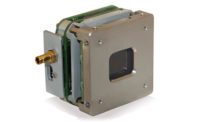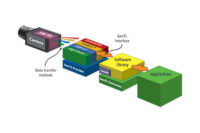Vision & Sensors - Standards
The Business Benefits of Machine Vision Standards
Meet the Future Standards Forum (FSF) of the machine vision industry.

Figure 1: Industry Associations collaborate on standards through the G3 & FSF. Source: Pleora

Figure 2: Responsibilities for Standards within the FSF. Source: Pleora


Standardization is incredibly important to any industry, and none more so than the relatively complex and globally distributed machine vision industry. Add to that the exceptional pace of technological development, and one quickly concludes that careful planning and coordination of interfaces, transport layers and digital protocols simply makes sense for manufacturers and end users alike. Recognizing that standardization coordination between industry associations was so critical, the AIA (North America), the European Machine Vision Association (EMVA), and the Japan Industrial Imaging Association (JIIA, Japan) entered into a cooperation agreement on standards called the “G3” in 2009. In 2012, through the efforts of a number of groups and individuals in the machine vision industry, the Future Standards Forum (FSF) was established as a working group under the umbrella of the G3 to provide the necessary standards oversight to help steer the large number of initiatives underway at any one time. This article looks at the primary reasons for the formation of the FSF, its objectives, and what it hopes to achieve.
Background
History reveals that when an industry competes with itself the consequences can be counter-productive. Consumers were once confused between the Betamax and VHS formats for video tape recording, which resulted in a decades-long industry war and costly developments that quickly became obsolete. Only when the key manufacturers agreed on the next generation DVD technology did business return to healthier levels.
Similar stories exist within the machine vision industry. For example, although the Camera Link HS and CoaXPress standards are technically quite different, they address similar user needs and some argue that they show little differentiation from each other. Both technologies were going through the standardization process at the same time through different industry associations on opposite sides of the globe: AIA in North America with Camera Link HS, and JIIA in Japan with CoaXPress. Interestingly, it was a member of EMVA who realized the potential benefits to all three associations further cooperating with each other, thereby hopefully avoiding similar issues in future—an idea embraced by all. While standards coordination efforts were already being undertaken through the G3 group, its mandate did not include oversight of the technical committees responsible for standards development.
Despite this lack of oversight, the machine vision industry has shown some very positive standards development initiatives, most notably in camera software interface technology with the GenICam and IIDC standards, the former of which is used across the GigE Vision, USB3 Vision, Camera Link, Camera Link HS, and CoaXPress standards. Both GenICam and IIDC are prime examples of how the cooperation between technical working groups and industry associations can optimize standards to the point where they are universally adopted by all. Similarly, the new USB3 Vision standard leverages much of the earlier work in streaming and control protocols that have been successfully implemented in GigE Vision, even though each standard addresses largely different market requirements.
The ultimate goal of the FSF is to provide standards roadmaps based upon industry requirements, and to drive the trend toward fewer standards, through the re-use and harmonization of existing ones. By observing technology trends and ensuring that standards are sufficiently differentiated from each other, any gaps that cannot be reasonably addressed by existing standards will lead to new ones being adopted or created.
Technical Committees
Standards are generally managed through technical committees within each of the industry associations, whose members are drawn from the ranks of the technical teams of industry manufacturers.
Within the FSF group, which is comprised of technical and non-technical members, some of whom are members of the technical standards committees, a much broader view of the industry will be adopted in order to validate that proposed standards and major standards updates support industry needs. The inherent objective will be to coordinate efforts between the different standards committees without limiting their creativity in developing their own ideas.
Coordination across all three standards bodies will help avoid overlap and duplication of effort, and ensure that the standards address the needs of customers while being compatible with the systems architectures in use.
Nothing prevents one of the industry associations from developing their own standards, but proposals are generally submitted in good faith to the G3, and if it gains support, the standard is developed and marketed globally. With the FSF providing good faith oversight on the evolution and creation of standards, it is in a position to best address the needs of our industry.
FSF Key Objectives
The FSF has set up two working groups, one for lighting standards and a second for interface standards. The FSF’s key goal in 2013 is to provide interface standards descriptions and comparison charts which supports one of the FSF’s objectives of communicating standards to end-users and also is a first step towards the FSF’s long-term objective of establishing roadmaps for standards. Because comparison charts compiled by individual companies tend to be biased in favor of commercial goals, those produced by the FSF should provide a non-partisan view of the current situation. Even charts assembled by a single industry association may be biased to promote the features of a particular standard. Therefore an important role of the FSF is to create standards descriptions and comparison charts that are approved by all of the committee chairs, thereby largely removing undue influence by any one group or individuals, and enhancing cooperation at all levels.
It should be noted that these roadmaps are standards-based and not product centric. Understandably, individual companies will want to protect their commercial and business interests; however, if a particular feature is not included in a standard, the feature runs the risk of never gaining broad acceptance. Conversely, a feature that is implemented in a standard will likely be enhanced through collaborative efforts, and benefit the industry and customers as a whole.
FSF Activities
So what are the immediate activities of the FSF? The first working meeting was convened in Korea in April 2013, with the next planned in Germany this coming October. One of the key deliverables will be the launch of a standards brochure at the Yokohama Vision Show in December. Standards comparison tables and descriptions will provide a critical baseline for the evolution of existing standards and recommendations for new ones, and, more importantly, will be a marketing tool to inform and promote the standards to others, both within and outside the machine vision sector. By reaching out to other industries, our market potential can be significantly expanded beyond conventional machine vision applications into such areas as the automotive, broadcast and ITS markets.
As we look to the future, providing the direction and oversight needed, will be a key measure of our success.
Looking for a reprint of this article?
From high-res PDFs to custom plaques, order your copy today!







